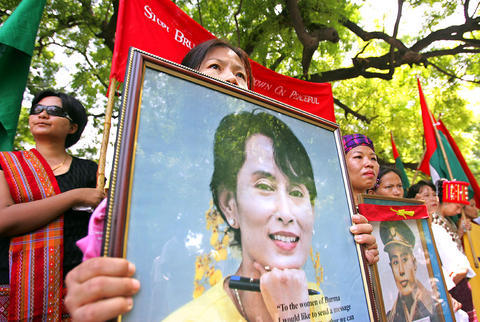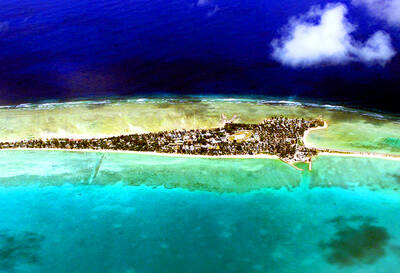Myanmar's military regime freed a wounded protester in a conciliatory gesture after tensions boiled over when Buddhist monks seized a group of officials as hostages, activists said yesterday.
Ye Thein Naing, who suffered a broken leg when authorities arrested a crowd of anti-junta protesters in Yangon on Aug. 28, was released during the night after being brought to a hospital for treatment, activists said.
A group of pro-democracy supporters jailed with Ye Thein Naing had staged a week-long hunger strike to demand medical attention for him, but they resumed eating after he was taken to hospital on Wednesday, activists said.

PHOTO: AP
Myanmar's military, which has ruled with an iron fist for 45 years, rarely shows such concern for the more than 1,000 political prisoners believed held in the nation's jails.
Rights groups frequently denounce the regime for refusing prisoners access to medical treatment. The Red Cross has not been allowed to visit Myanmar's prisons for nearly two years.
"This time they let the person go to the hospital and release him -- it's a small concession. They are worried that things could escalate" after the hostage crisis on Thursday at the monastery, Thailand-based analyst Win Min said.
The showdown in Pakokku, about 500km north of Yangon, was the most serious confrontation since protests began on Aug. 19.
Twenty government and security officials were held hostage for several hours, as monks torched four of their cars.
After the officials were freed, about a dozen monks marched through the town and trashed an electronics shop owned by a local militia leader.
The monks were enraged after soldiers fired warning shots into the air to break up a march on Wednesday, when some 300 Buddhist clergy walked through the streets praying in solidarity with the people after a massive hike in fuel prices.
Pro-junta militia then beat the crowd with bamboo sticks, according to residents, who lined the streets to cheer the monks' march and the hostage-taking.
Pakokku is a major center of Buddhist learning in Myanmar, and analysts said the crisis at the monastery raised the risk that other teaching temples around the country could mobilize their monks.
The military and the Buddhist clergy are the two most important institutions in Myanmar and the only groups that maintain networks stretching across the entire country formerly known as Burma.
Monks were credited with rallying popular support for a pro-democracy uprising in 1988, which was crushed by the military, when soldiers opened fire on protesters, killing hundreds, if not thousands.
In an unusually swift commentary on the situation in Pakokku,state media on Friday accused the monks of trying "to create public outrage in order to intentionally incite a mass protest like '88 unrest."
The protests last month were spearheaded by student leaders of the 1988 uprising, who spent more than a decade in prison but were released over the last three years.
The latest crackdown sparked an international outcry.
US President George W. Bush attacked the regime while attending the APEC summit in Sydney.
"We must press the regime in Burma to stop arresting, harassing, and assaulting pro-democracy activists for organizing or participating in peaceful demonstrations," he said yesterday.

DISASTER: The Bangladesh Meteorological Department recorded a magnitude 5.7 and tremors reached as far as Kolkata, India, more than 300km away from the epicenter A powerful earthquake struck Bangladesh yesterday outside the crowded capital, Dhaka, killing at least five people and injuring about a hundred, the government said. The magnitude 5.5 quake struck at 10:38am near Narsingdi, Bangladesh, about 33km from Dhaka, the US Geological Survey (USGS) said. The earthquake sparked fear and chaos with many in the Muslim-majority nation of 170 million people at home on their day off. AFP reporters in Dhaka said they saw people weeping in the streets while others appeared shocked. Bangladesh Interim Leader Muhammad Yunus expressed his “deep shock and sorrow over the news of casualties in various districts.” At least five people,

ON THE LAM: The Brazilian Supreme Court said that the former president tried to burn his ankle monitor off as part of an attempt to orchestrate his escape from Brazil Former Brazilian president Jair Bolsonaro — under house arrest while he appeals a conviction for a foiled coup attempt — was taken into custody on Saturday after the Brazilian Supreme Court deemed him a high flight risk. The court said the far-right firebrand — who was sentenced to 27 years in prison over a scheme to stop Brazilian President Luiz Inacio Lula da Silva from taking office after the 2022 elections — had attempted to disable his ankle monitor to flee. Supreme Court judge Alexandre de Moraes said Bolsonaro’s detention was a preventive measure as final appeals play out. In a video made

It is one of the world’s most famous unsolved codes whose answer could sell for a fortune — but two US friends say they have already found the secret hidden by Kryptos. The S-shaped copper sculpture has baffled cryptography enthusiasts since its 1990 installation on the grounds of the CIA headquarters in Virginia, with three of its four messages deciphered so far. Yet K4, the final passage, has kept codebreakers scratching their heads. Sculptor Jim Sanborn, 80, has been so overwhelmed by guesses that he started charging US$50 for each response. Sanborn in August announced he would auction the 97-character solution to K4

SHOW OF FORCE: The US has held nine multilateral drills near Guam in the past four months, which Australia said was important to deter coercion in the region Five Chinese research vessels, including ships used for space and missile tracking and underwater mapping, were active in the northwest Pacific last month, as the US stepped up military exercises, data compiled by a Guam-based group shows. Rapid militarization in the northern Pacific gets insufficient attention, the Pacific Center for Island Security said, adding that it makes island populations a potential target in any great-power conflict. “If you look at the number of US and bilateral and multilateral exercises, there is a lot of activity,” Leland Bettis, the director of the group that seeks to flag regional security risks, said in an